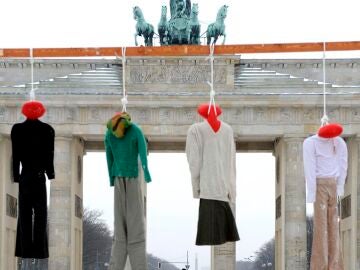
Iran Friday night experienced new protests in several cities of the country spurred by the execution of three protesters for crimes allegedly committed during the revolt unleashed by the death of Mahsa Aminiafter several months of calm in the streets of the Persian country.
Protests occurred in cities like Karaj, Tehran or Isfahan and mainly young Iranians participated in them in small groups, who sang slogans against the authorities, according to videos posted on social media by activist groups. “Death to the government of the executioners”, shouted young people in Tehran, where small demonstrations took place in various parts of the city.
In the capital, shouts were also heard again from the windows of the buildings against the supreme leader of Iran, Ali Khamenei, and the Islamic Republic. In cities including Karaj and Isfahan, protesters chanted “death to the dictator” and “death to Khamenei,” according to videos from human rights groups. In Karaj there were also protests in front of the Ghezel Hesar prison, where they are imprisoned various convicted prisoners to death for his participation in the protests sparked by the death of Mahsa Amini in September.
The small protests last night are the first after several months of tranquillity. The last significant demonstrations occurred in mid-March, during the Persian New Year celebrations. The new signs of social discontent occurred after the execution yesterday at the gallows of three prisoners convicted for their alleged involvement in the death of three members of the security forces in November during the protests over the death of Amini. Saleh Mirhashmi, Majid Kazemi and Saeed Yaqoubi were hanged at dawn after being sentenced to death in January in a trial in which forced confessions were used, denounced Amnesty International (AI).
With the hangings of Mirhashmi, Kazemi and Yaqoubi, there are now seven people who have been executed for alleged crimes related to the protests unleashed by the death of Amini. The European Union condemned the last yesterday’s executions in Iran and demanded that the government put an “immediate” end to the death penalty sentences. “The EU urges the Iranian authorities not to apply the death penalty and to carry out future executions, as well as to adopt a coherent policy towards the abolition of the death penalty,” a spokesman for the High Representative for Foreign Affairs said in a statement. Foreign Affairs of the EU, Josep Borell. The death in police custody of Amini after being arrested for not wearing the Islamic headscarf prompted the biggest protests against the Islamic Republic and the country’s theocratic system in decades. The protests had disappeared after a strong state repression that has caused some 500 deaths and thousands of arrests, in addition to executions. Of all the forms of protest and disobedience, the only one that survived is the rejection of the veil by a lot of women despite the attempts of the authorities to reinstate the use of this garment.
Source: Lasexta
Ricardo is a renowned author and journalist, known for his exceptional writing on top-news stories. He currently works as a writer at the 247 News Agency, where he is known for his ability to deliver breaking news and insightful analysis on the most pressing issues of the day.












